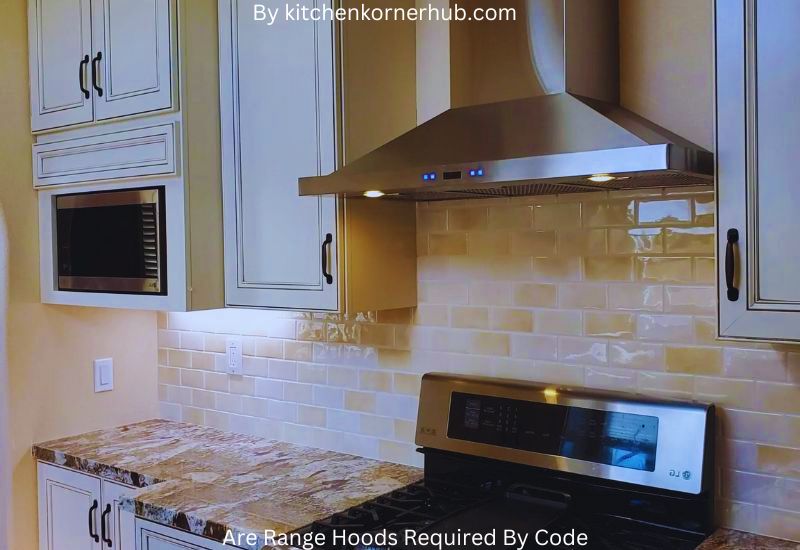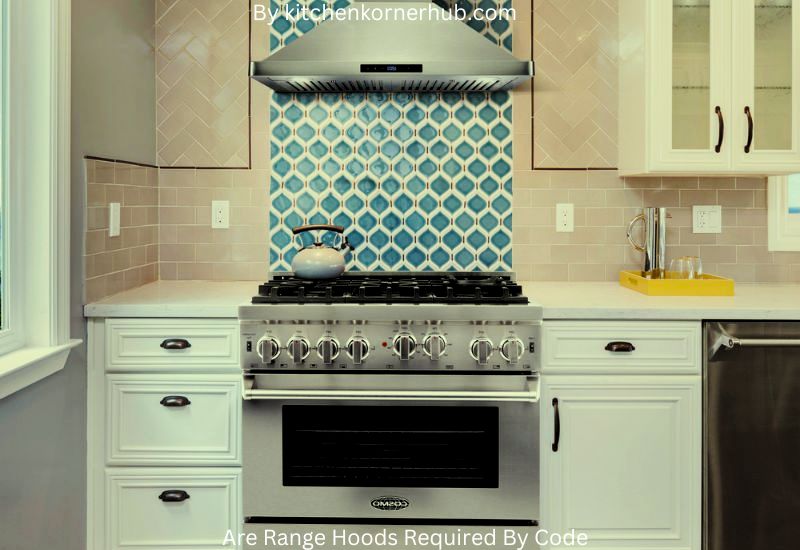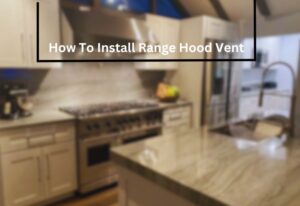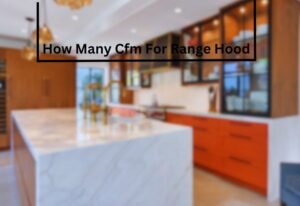Introduction:
When it comes to kitchen safety and functionality, range hoods play a crucial role. But have you ever wondered if having a range hood in your kitchen is a matter of choice or a legal requirement? In simple terms, a range hood is a ventilation device designed to remove smoke, odors, and pollutants generated during cooking. However, whether you need one in your kitchen depends on local building codes and regulations.
Building codes are like the rules of the road for construction and renovation projects. They outline the minimum standards that ensure structures are safe for occupancy and meet certain health and environmental standards. Range hoods fall under these codes due to their ability to improve indoor air quality and prevent potential fire hazards. These codes vary from place to place, so it’s essential to understand the requirements specific to your location before embarking on any kitchen renovation or construction project.
Are Range Hoods Required By Code? Range hoods are often required by building codes, especially when installing gas or electric cooktops. They help remove smoke, odors, and airborne grease, ensuring indoor air quality and safety. Check local building codes to determine specific requirements in your area.
In this article, we will delve deeper into the topic of range hoods and their necessity according to building codes. We’ll explore different types of range hood systems, the benefits they offer, and the factors that might influence whether you need one installed in your kitchen. So, let’s navigate the realm of kitchen ventilation codes to ensure your culinary space is both safe and enjoyable to use.
Understanding Building Codes and Kitchen Appliances

When it comes to designing and constructing a functional and safe kitchen space, the incorporation of kitchen appliances must align with relevant building codes.
Building codes serve as a set of regulations and standards that ensure the safety, efficiency, and accessibility of structures. This extends to the selection, installation, and use of kitchen appliances, which play a significant role in the overall functionality of any kitchen.
Importance of Building Codes:
Building codes are essential guidelines that dictate the minimum standards for construction, including the installation of kitchen appliances. These codes are formulated by regulatory bodies to guarantee the safety of occupants and to prevent potential hazards such as electrical fires, gas leaks, and structural failures.
Building codes cover a range of aspects including electrical systems, plumbing, ventilation, and fire safety, all of which are directly related to the integration of kitchen appliances.
Electrical Considerations:
The integration of kitchen appliances demands careful attention to electrical codes. These codes determine factors such as the type and rating of wiring, outlets, and circuit breakers required to accommodate the appliances’ power demands.
It’s crucial to follow these codes to prevent overloading circuits, which could lead to electrical fires. GFCI (Ground Fault Circuit Interrupter) outlets are often mandatory in kitchens as they provide protection against electrical shocks, an important consideration when installing appliances near water sources.
Gas Appliances and Ventilation:
For kitchens equipped with gas appliances like stoves and ovens, adherence to gas codes is paramount. Proper installation and ventilation are critical to prevent gas leaks and ensure efficient combustion.
Ventilation codes, on the other hand, are designed to maintain air quality by expelling odors, smoke, and potentially harmful gases produced during cooking. Range hoods, for example, must be installed in a way that complies with ventilation requirements to ensure a safe and comfortable cooking environment.
Accessibility and Universal Design;
Building codes also emphasize accessibility and universal design principles, which are particularly important in kitchen spaces.
These codes ensure that kitchen appliances are placed at appropriate heights and are usable by people with various physical abilities. For instance, codes might dictate the height of countertops, the clearance under sinks for wheelchair users, and the proper placement of handles on appliances for easy access.
Fire Safety and Material Choices:
Fire safety codes are crucial considerations in kitchen design due to the presence of heat sources and flammable materials. Appliances like ovens and stoves need to be properly insulated and positioned to avoid ignition of adjacent materials.
Building codes might also dictate the use of fire-resistant materials in certain areas of the kitchen. These codes contribute to minimizing fire hazards and enhancing the overall safety of the kitchen environment.
Importance of Proper Ventilation in Residential Kitchens

When it comes to creating a functional and safe kitchen environment, proper ventilation stands out as a crucial element that often goes unnoticed.
A well-ventilated kitchen is not only a matter of comfort but also plays a significant role in maintaining indoor air quality, enhancing cooking efficiency, and ensuring the overall well-being of the occupants. Here, we delve into the key reasons why proper ventilation is vital in residential kitchens.
Health and Indoor Air Quality:
Cooking activities release a variety of airborne pollutants, such as smoke, grease particles, and odors. Without adequate ventilation, these pollutants can accumulate in the indoor air, leading to poor indoor air quality and potential health risks.
Proper ventilation effectively removes these contaminants, promoting a healthier living environment and reducing the chances of respiratory issues and allergies.
Odor Control:
Adequate ventilation plays a crucial role in eliminating cooking odors that can linger long after meal preparation. The accumulation of strong odors not only affects the comfort of the inhabitants but also gives rise to an unpleasant living atmosphere.
A well-designed ventilation system with features like range hoods or exhaust fans helps in swiftly expelling cooking odors, keeping the kitchen and adjoining areas smelling fresh.
Moisture and Mold Prevention:
Cooking activities, especially boiling and steaming, generate moisture in the kitchen. Excess moisture can lead to mold growth, which poses a threat to both the structural integrity of the kitchen and the health of the occupants.
Proper ventilation helps in reducing moisture buildup, preventing the growth of mold and mildew, and safeguarding the kitchen from potential water damage.
Cooking Efficiency:
A well-ventilated kitchen contributes to better cooking efficiency. Adequate airflow prevents excessive heat buildup during cooking, maintaining a comfortable environment for the chef.
It also prevents condensation on surfaces, allowing for smoother cooking processes and ensuring that delicate dishes are prepared with precision.
Safety Enhancement:
Proper ventilation not only maintains indoor air quality but also improves safety in the kitchen. Efficient ventilation helps prevent the buildup of combustible gases like carbon monoxide, reducing the risk of fires or gas leaks.
It also helps dissipate excess heat, minimizing the chances of burns and other cooking-related accidents.
Building Codes and Indoor Air Quality Regulations

Building codes and indoor air quality (IAQ) regulations play a crucial role in ensuring the health, safety, and comfort of occupants within buildings. These guidelines are designed to set standards for the construction, design, and maintenance of buildings, focusing on aspects that contribute to maintaining a healthy indoor environment.
IAQ is of paramount importance, as poor air quality can lead to a range of health issues, including respiratory problems, allergies, and even long-term diseases. Here, we delve into the significance of building codes and IAQ regulations in maintaining optimal indoor air quality.
Building Codes and Health Considerations:
Building codes are established by local, national, or international authorities to establish minimum requirements for the construction and operation of buildings. In recent years, there has been a growing emphasis on incorporating health considerations into these codes.
Recognizing the impact of indoor air quality on occupant health, many codes now include provisions related to ventilation, filtration, and the prevention of indoor air pollutants. These provisions help create a foundation for maintaining a healthy indoor environment.
Ventilation Standards and IAQ:
Proper ventilation is a key factor in ensuring good indoor air quality. Building codes outline requirements for adequate ventilation rates, ensuring that a sufficient amount of fresh outdoor air is supplied and circulated within buildings.
This helps dilute indoor pollutants and prevents the accumulation of harmful substances. These codes may specify ventilation systems, air exchange rates, and methods for measuring ventilation effectiveness to ensure that occupants breathe clean air.
Materials and Emissions:
Modern construction materials and furnishings can release volatile organic compounds (VOCs) and other pollutants into the air, a phenomenon known as “off-gassing.” Building codes increasingly address this concern by setting limits on the emissions of VOCs from materials used in building construction and interior design.
These regulations promote the use of low-emission materials, reducing the potential for indoor air pollution and its associated health risks.
Maintenance and IAQ Compliance:
Building codes extend beyond initial construction and cover the ongoing maintenance of structures. Regular maintenance is crucial for upholding indoor air quality standards.
Codes may require regular inspections and maintenance of ventilation systems, ensuring that filters are changed, ducts are cleaned, and systems are functioning optimally. By enforcing proper maintenance practices, codes contribute to the long-term preservation of indoor air quality.
Monitoring and Adaptation:
Indoor air quality regulations are not static; they evolve to address emerging concerns and advancements in knowledge. Building codes often incorporate provisions for monitoring indoor air quality, allowing building owners to assess the effectiveness of their ventilation systems and identify potential issues.
As research uncovers new insights into IAQ, codes can be adapted to reflect the latest best practices, technology, and understanding of indoor air quality management.
Residential Kitchen Ventilation Standards: A Closer Look

Introduction Residential kitchen ventilation standards play a pivotal role in ensuring indoor air quality, energy efficiency, and overall health and comfort within our homes. With cooking being a daily activity in most households, proper ventilation is crucial to mitigate the potential negative impacts of cooking byproducts on indoor air.
This article delves into the significance of residential kitchen ventilation standards, their key components, and the benefits they offer.
Importance of Proper Ventilation
Effective kitchen ventilation goes beyond simply removing cooking odors; it also addresses the release of harmful pollutants, such as volatile organic compounds (VOCs) and carbon monoxide, which can result from cooking processes.
Without adequate ventilation, these pollutants can accumulate, leading to poor indoor air quality that may trigger respiratory issues and other health concerns. Furthermore, proper ventilation helps to prevent moisture buildup, which can lead to mold growth and structural damage over time.
Key Components of Ventilation Standards
Residential kitchen ventilation standards encompass various elements to ensure optimal performance. These include the calculation of ventilation rates based on kitchen size, appliance type, and cooking frequency.
Standards also emphasize the use of efficient exhaust fans or range hoods capable of adequately capturing and expelling pollutants. Moreover, guidelines often suggest positioning these exhaust systems directly above cooking surfaces to ensure efficient pollutant removal. Filter maintenance and noise control are additional aspects addressed within these standards, promoting long-term functionality and user comfort.
Energy Efficiency and Sustainability
Modern residential kitchen ventilation standards are increasingly aligned with energy efficiency and sustainability goals.
Homeowners are encouraged to select exhaust systems with high-efficiency motors and lighting, as well as options that incorporate heat recovery mechanisms to reduce energy consumption. By adhering to these standards, homeowners can contribute to reduced energy bills and lower environmental impact, making their kitchens both healthier and more sustainable spaces.
Balancing Technology and User Behavior
While ventilation technology continues to advance, user behavior remains a critical factor in ensuring effective pollutant removal. Even the most advanced ventilation systems require proper usage to achieve their full potential.
Homeowners are advised to operate exhaust fans or range hoods during cooking and for a short time afterward to ensure that residual pollutants are expelled. This combination of cutting-edge technology and responsible behavior creates a harmonious synergy in maintaining excellent indoor air quality.
Conclusion
In conclusion, the necessity of range hoods as mandated by building codes is a matter of ensuring safety, indoor air quality, and compliance with regulations. While not all jurisdictions may have explicit requirements, the installation of range hoods, particularly in kitchens with gas stoves, is strongly recommended to mitigate potential health hazards and fire risks. The inclusion of range hoods in building codes underscores their importance in maintaining a healthy and secure living environment. As such, homeowners and builders should carefully consider the benefits of range hoods even in areas where they are not explicitly mandated by code.
Frequently Asked Question(Are Range Hoods Required By Code)
What is code for a range hood?
In residential building codes, the installation of a range hood is often regulated. While specific codes can vary by location, many jurisdictions require that a range hood be installed in kitchens, especially when a gas stove is present.
The codes generally stipulate ventilation requirements, including the capacity of the hood, the minimum distance it should be from the stove, and the type of exhaust system needed. Adhering to these codes ensures proper ventilation and safety in the kitchen.
Is it OK to not have a range hood?
While it might be technically possible to have a kitchen without a range hood, it’s generally recommended to have one, especially if you have a gas stove. Range hoods play a crucial role in removing airborne particles, grease, and odors that cooking can generate.
Without a range hood, these substances can accumulate in your kitchen and even affect indoor air quality. Additionally, for homes with gas stoves, a range hood is important to properly vent out any potentially harmful combustion byproducts, ensuring the safety of the occupants.
Are kitchen hoods required?
The requirement for kitchen hoods is often dictated by local building codes and regulations. These codes aim to ensure the safety, health, and functionality of residential spaces. Depending on the jurisdiction, there might be variations in the specific requirements for kitchen hoods, such as when they are mandatory, what type of hoods are allowed, and the ventilation capacity needed.
Generally, kitchen hoods are required, especially when certain conditions are met, such as the presence of a gas stove or specific cooking activities that generate significant amounts of smoke, grease, or fumes.
Is it code to have a range hood for a gas stove?
Yes, many building codes require the installation of a range hood for a gas stove. Gas stoves produce combustion byproducts, including carbon monoxide, which need to be properly vented to the outside to ensure the safety of occupants.
A range hood equipped with an appropriate exhaust system helps remove these byproducts, along with other cooking-related pollutants like grease and odors. The specifics of the code can vary depending on the jurisdiction, but it’s generally a safety measure to have a range hood when using a gas stove.
What stove does not require a hood?
A stove that typically doesn’t require a hood is an electric stove with smooth, glass or ceramic cooktop surfaces. These electric stoves are designed to be more energy-efficient and emit less heat and smoke compared to traditional gas stoves. Since they generate fewer cooking byproducts like open flames or excessive heat, they generally do not require a range hood for ventilation.
However, it’s essential to check your local building codes and regulations, as requirements may vary depending on your location. Some local codes may still recommend or require a range hood even for electric stoves to ensure proper air circulation and removal of any cooking odors or moisture.
Is a range hood required for electric stove?
To sum it up, in most cases, an electric stove with a smooth glass or ceramic cooktop does not require a range hood, but it’s crucial to verify local regulations to ensure compliance with safety and ventilation standards.




